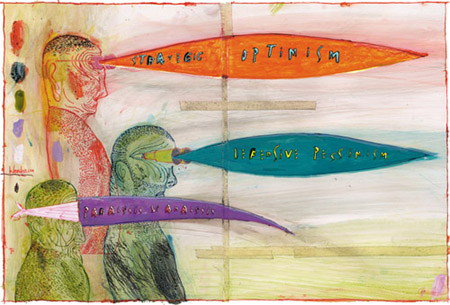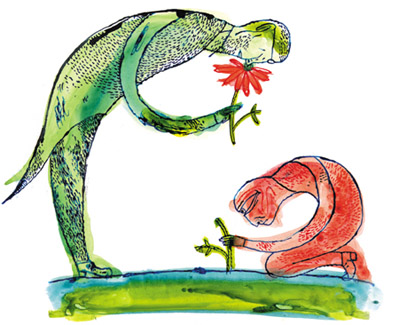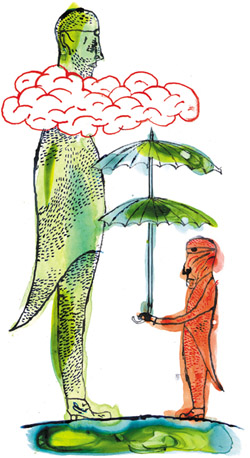 Nattering
nabobs of negativity have a strategy that works as well as positive thinking.
Too bad it doesn't work for everyone.
Nattering
nabobs of negativity have a strategy that works as well as positive thinking.
Too bad it doesn't work for everyone.
What if you
don't finish reading this article? What if you don't even start it? What if the
statistics don't add up? What if it fails miserably at conveying its point? What
if you dislike its protagonist-an unassuming psychologist in Wellesley, Massachusetts?
What if you think her research is dumb? What if you think it's not only dumb but
out-and-out wrong-and you're someone who would know because you have your own
doctorate in psychology? What if the Magazine's printer leaves out the
story's last page, or the entire issue gets shredded in the mail? What if the
damn thing is full of typos or modifiers misplaced in embarrassing places? What
if all this fretting irritates you so much that the last thing you want to do
is continue reading?
 Now
for a plan of attack.
Now
for a plan of attack.
Although the Magazine
can't control whether you like Julie K. Norem, AB'82-much less whether the printer
or the post office gets its job done-we can control accuracy, cite convincing
evidence, and provide the "Letters" section for you to tell us where
we-or Norem-err. We can proofread, check facts, muster our creativity, give it
our all despite everything that could go wrong.
As
for whether this multiparagraph exercise irritates you-well, you're probably a
strategic optimist, so you wouldn't understand. For those who hear yourselves
in this assembly of worst-case scenarios and contingency plans, welcome to Norem's
favorite research population. You're a defensive pessimist.
It's
mid-June on the Wellesley College campus, and Norem, a specialist in personality
and social psychology, is reading aloud from her letters file. "This is a
typical one: 'Dear Dr. Norem, For seven years I've read almost every positive-thinking
book on the market, yet my attitude steadily grew worse. My self-condemnation
for being so negative led to depression, anxiety, and terribly low self-esteem.
"'Then I found your book yesterday,'"
Norem reads on. "'There's nothing wrong with me! There was nothing wrong
with mom and dad either! We are all defensive thinkers! I cannot tell you the
freedom and release I feel. I even brought out my Eeyore toy. I always hated Eeyore
because I thought he was so negative. Not so.'"
Since
Norem's book, The Positive Power of Negative Thinking, was published by
Basic Books last December, she's received a steady stream of grateful responses.
Many come from therapists and clinicians who treat fretful, anxious patients,
the kind of people whom others avoid because their negative harping can be both
depressing and counterproductive-or so it seems to more optimistic types. Norem's
correspondents recognize in her research a workable method for helping such people
manage their anxiety and tackle intimidating tasks.
The
key to Norem's studies is where they begin. While her peers in academe divide
the world into positive and negative thinkers and preach the power of positive
thinking to the schlubs lumped in the negative camp, Norem draws different cross-sections,
leading her to make different recommendations. Rejecting "positive"
and "negative" as too general, she begins by looking at psychological
states, separating persons who are by nature anxious from those who aren't. Nonanxious
persons probably use what she calls strategic optimism.
Next
she seeks out those who are anxious about the future rather than those whose anxiety
stems from dwelling on the past-the latter are so-called dispositional pessimists
and are the subjects of most negative-thinking studies. Among the future-oriented
anxious group she distinguishes between those who can tolerate their anxiety enough
to accomplish their goals (defensive pessimists-Norem's specialty) and those who
are overwhelmed by it. Members of this last group tend to experience "premature
cognitive narrowing," or paralysis by analysis. They either avoid anxiety-inducing
situations entirely or subconsciously self-handicap by procrastinating or self-medicating
with drugs or alcohol when faced by daunting tasks.
Because
humans are complex creatures, it's possible to be more than one "type."
Which strategy you use, Norem explains, "depends. Everything depends"-on
the situation, on your environment, on what you consciously hope to achieve. In
any particular domain-work, social interaction, home life-about 25 to 30 percent
of Americans, Norem estimates, consistently use defensive pessimism, while 30
percent consistently use strategic optimism. That's roughly how subjects have
divided up in Norem's studies over 18 years. Her samples have ranged from 60 nursing
students to 498 Northeastern University undergraduates. (And the distinction about
nationality is important, Norem says, because Americans tend to insist on optimism.
In Asia defensive pessimism is more the norm. Since Norem's book was released
in Taiwan this past June - its title translated as I'm Pessimistic But I Achieve
- it's been selling like Starbucks.)
As for the
other 40 to 45 percent, we may be inconsistent in our strategy, flip-flopping
without noticing if one works better; we may have no strategy, avoiders and self-handicappers
who succumb to paralysis by analysis; or we still may be developing a strategy
because we lack experience in that domain or situation, as might be the case for
a parent preparing for her eldest child to go away for college.
Ultimately,
Norem says, it's all about goals. "A strategic optimist's unconscious goal
is not to become anxious. A defensive pessimist's unconscious goal is not to run
away." So defensive pessimists-who, despite being future focused, tend to
be very aware of their faults and past mistakes-conquer their urge to flee by
conjuring worst-case scenarios and a multitiered plan. But strategic optimists-who
are by nature positive about their past performance and confident in their continued
ability to do well-actively distract themselves from considering how they'll do
on the task ahead.
In her book Norem gives the
example of a strategic-optimist architect who reads travel brochures before big
presentations, while his defensive-pessimist partner is busy making extra photocopies
just in case. The self-handicapper, meanwhile, is still writing her presentation
in the taxi en route to the meeting, and the avoider sorts envelopes in the mail
room, too freaked out by the prospect of giving presentations to choose a career
that might require such a stressful unknown in the first place.
On
first impressions alone, one might conclude that Norem is a strategic optimist.
She's blond, has a confident stride, and on this particular day wears a brilliant
fuchsia blazer. Her book is written in a relaxed, chatty voice. She was recently
promoted to full professor. And while the prospect of developing an entirely new
psychometric methodology might lead a less confident researcher to stick with
laboratory experiments-Norem is among the first to study defensive pessimists,
so she's had to figure out the best questions to ask these new subjects-she has
created a solid portfolio of real-life and longitudinal studies.
Yet
her office has the tell-tale signs of a self-handicapper: piles of paper totter
on stacks of books, transparencies spill from three-ring binders. Of course, she's
one day away from her first sabbatical, so she may still be devising a strategy
for this situation.
When asked where she falls
on her research continuum, she first classifies herself as anxious (a fairly recent
self-discovery: "I've spent a lot of time and effort withholding anxious
feelings from myself"), then specifies her strategy by domain. At work, she's
a recovering self-handicapper striving to use defensive pessimism consistently.
"I can't think of a single time in my work life that I've been overprepared,"
she says. "It was a surprise to realize there was a more effective way of
dealing with things." At home she's a strategic optimist turned defensive
pessimist, the confident wife who never considered worst-case scenarios until
motherhood struck and her sense of control disintegrated in the peanut-butter-covered
faces of toddlers.
Telling a frazzled mother to
stop worrying and look on the bright side doesn't help her problem-solve, and
such advice, Norem has learned, is equally pointless for a defensive pessimist.
 After
graduating from Chicago 20 years ago, Norem entered the University of Michigan's
graduate program in psychology, where she met professor Nancy Cantor, a defensive
pessimist who actually coined the term (and who is now chancellor of the University
of Illinois at Urbana-Champaign). Cantor taught Norem that, given the same situation,
some persons "see through the lens of anxiety and others don't."
After
graduating from Chicago 20 years ago, Norem entered the University of Michigan's
graduate program in psychology, where she met professor Nancy Cantor, a defensive
pessimist who actually coined the term (and who is now chancellor of the University
of Illinois at Urbana-Champaign). Cantor taught Norem that, given the same situation,
some persons "see through the lens of anxiety and others don't."
If
defensive pessimism was indeed a strategy for managing anxiety, Norem reasoned,
then interfering with it at critical points would demonstrate how the process
worked and whether it was as successful a strategy as positive thinking was typically
proclaimed to be. So she and Cantor ran a series of experiments intended to tinker
with defensive pessimists' thought processes. From a questionnaire similar to
that on page 51, they culled subjects who fell on the extreme ends of the defensive
pessimism/strategic optimism spectrum.
In one
study some defensive pessimists were asked to predict their performance on a standardized
test. Defensive pessimists, as part of their strategy and complicated self-concept,
tend to set low self-expectations before a task, building confidence by drawing
up contingency plans. Members of this group, true to form, expected to perform
poorly. Meanwhile, other defensive pessimists were simply assured that, given
their "records," they should expect to perform well on the test. These
subjects set significantly higher expectations for their performance than the
first group did. Norem guessed that, among these defensive pessimists, positive
expectations would cause complacency, resulting in a failure to use their tried-and-true
strategy for success. She was right: this group's performance fell well below
that of the first.
In another study strategic
optimists and defensive pessimists participated in a dart-throwing exercise. The
subjects were randomly assigned to prepare in one of three ways. The first group
engaged in what cognitive-behavioral therapists call "coping imagery,"
imagining something going wrong (such as hitting the researcher with a dart) and
taking steps to prevent it. The second group practiced what sports-psychologists
call "mastery," imagining a flawless performance. The third did a relaxation
exercise, distracting themselves by visualizing a peaceful scene such as a beach.
The study's defensive pessimists, Norem found, did best when they used coping
imagery. Their performance declined when they imagined performing perfectly, and
they did even worse when asked to behave like optimists and distract themselves.
In contrast, strategic optimists performed best after the relaxation exercise
and worst when they imagined things going wrong.
Norem
next wondered how forcing worrywarts to take their minds off their troubles by
keeping busy would affect their performance. She again provoked subjects' anxiety
with an aptitude test. Before the test some defensive pessimists were told to
outline possible outcomes; others were assigned random clerical work. The busywork,
Norem reasoned, would keep them from rehearsing worst-case scenarios. Her results
confirmed that suspicion: the second group's performance was considerably below
that of the first.
Worries, Norem concluded, are
exactly what defensive pessimists need on their minds. Trusting in their
abilities by setting high expectations or distracting themselves by "thinking
good thoughts" or staying busy can hinder their performance.
Because
life, unlike these experiments, doesn't exist in a laboratory, Norem tested her
findings in the real world. She asked 60 nursing students to outline their personal
goals, which ranged from "saving to buy a house" to "rescuing a
nephew from life on the streets." Subjects were equipped with beepers that
randomly reminded them five times a day to fill out a questionnaire about what
they were doing, whom they were with, how they felt, and whether their current
activity was relevant to their personal goals. Some subjects were also asked to
reflect on their progress toward those goals. At the study's end a semester later
the defensive pessimists-and only the defensive pessimists-who did the reflection
exercise reported less anxiety and more satisfaction. They also had made considerable
progress toward their goals.
Similar findings
came from Norem's longitudinal study of 90 members of the Wellesley Class of 1997,
whom she followed through various major life events beginning with the 1993 new-student
orientation. In each situation-entering college, choosing a major, graduating,
finding a job, engaging in intimate relationships, having a child, switching jobs
or careers-defensive pessimists' anxiety levels peaked before the event, as they
conjured frightening scenarios. Yet afterward they reported outcomes as successful
as those of strategic optimists.
 Gaining
the tools to dig up our beloved Eeyore and finally understand him is no
small gift. And judging from the rubber necking in airports and on trains inspired
by a book whose proud purple and yellow cover touts the power of negative thinking,
Norem is onto something. Yet most researchers in personality and social psychology,
she notes with frustration, don't pay attention to her work. Those who do point
to her early longitudinal studies, which failed to prove that defensive pessimism
is an "adaptive" strategy-that is, one that leads to successful outcomes,
which she has now proven. Norem attributes this early failure to a lack of experience
with the methodology. Now that she's tenured and published-and has learned the
ropes of longitudinal studies-"I'm the token dissenter among the positive
psychologists at all the meetings," she jokes.
Gaining
the tools to dig up our beloved Eeyore and finally understand him is no
small gift. And judging from the rubber necking in airports and on trains inspired
by a book whose proud purple and yellow cover touts the power of negative thinking,
Norem is onto something. Yet most researchers in personality and social psychology,
she notes with frustration, don't pay attention to her work. Those who do point
to her early longitudinal studies, which failed to prove that defensive pessimism
is an "adaptive" strategy-that is, one that leads to successful outcomes,
which she has now proven. Norem attributes this early failure to a lack of experience
with the methodology. Now that she's tenured and published-and has learned the
ropes of longitudinal studies-"I'm the token dissenter among the positive
psychologists at all the meetings," she jokes.
And
there are many positive psychologists. Norem's research, in fact, calls into question
the methods of the positive-psychology movement that for the past two decades
has dominated academic research. The movement's emphasis on positive thinking
is intended, University of Pennsylvania psychologist Martin Seligman and its other
champions have said, to be an antidote to a field preoccupied with illness and
disorder.
Yet their work, argues Norem, inappropriately
lumps defensive pessimists in with other negative thinkers. Because defensive
pessimists report high anxiety levels and certainly sound pessimistic, they are
grouped with those who have negative dispositions and pessimistic attributional
styles, such as dwelling on the past and believing that nothing will ever go well-thoughts
defensive pessimists decidedly don't have. In fact, when anxiety is statistically
removed from pessimism studies, Norem has shown, defensive pessimists turn out
to be no more pessimistic than strategic optimists, who aren't dealing with anxiety
anyway.
Norem is not alone in studying negativity,
but her approach makes her distinct. At "The (Overlooked) Virtues of Negativity"
symposium, part of the American Psychological Association's 2000 meeting, she
was the only researcher focusing on strategy and process, goals and progress.
Being the odd person out hasn't affected Norem's
own disposition. Reflecting on her time at Chicago, she notes that she has very
few visual memories of people. "I think that's because I was listening to
rather than looking at them," she says. "We were always exploring an
idea for fun, over beer, over dinner. It was the only place I've ever been where
every discussion began with Aristotle."
Norem
credits Chicago for her persistence, and employing her defensive pessimism, she
focuses on the future. An interesting personality trait has shown up in the part
of her Wellesley Class of 1997 studies that tracks self-concept: the fear of being
an imposter. Until now, the "impostor phenomenon" has been accounted
for only anecdotally in psychology literature. Norem is intrigued. She's already
considering her next research population: a group of Illinois men about to become
fathers. She's devoting her sabbatical to reading everything she can find on impostors
and devising a methodology for her next longitudinal study. The big question for
the defensive pessimist in her now is, what if…?


![]() Contact
Contact
![]() About
the Magazine
About
the Magazine ![]() Alumni
Gateway
Alumni
Gateway ![]() Alumni
Directory
Alumni
Directory ![]() UChicago
UChicago![]() ©2002 The University
of Chicago® Magazine
©2002 The University
of Chicago® Magazine ![]() 5801 South Ellis Ave., Chicago, IL 60637
5801 South Ellis Ave., Chicago, IL 60637![]() fax: 773/702-0495
fax: 773/702-0495 ![]() uchicago-magazine@uchicago.edu
uchicago-magazine@uchicago.edu Nattering
nabobs of negativity have a strategy that works as well as positive thinking.
Too bad it doesn't work for everyone.
Nattering
nabobs of negativity have a strategy that works as well as positive thinking.
Too bad it doesn't work for everyone. Now
for a plan of attack.
Now
for a plan of attack. After
graduating from Chicago 20 years ago
After
graduating from Chicago 20 years ago Gaining
the tools to dig up our beloved Eeyore
Gaining
the tools to dig up our beloved Eeyore